Informationsschnipsel
Dachbegrünung
Stationen einer Dachbegrünung
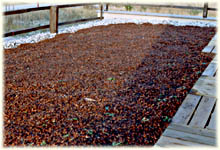
Eine am Haus befindliche Garage mit einer Grundfläche von 30 qm soll begrünt werden. Als Substrat kommt ein Gemisch aus Recyclingmaterial, vulkanischen Gestein und Erde zum Einsatz. Die durchschnittliche Aufbauhöhe beträgt 12 cm. Eine Extensivbegrünung mit Mauerpfefferarten soll ein pflegeleichtes Biotop bilden.
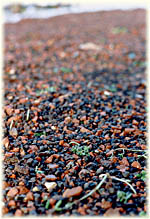
Das Substrat wurde im Sommer 1999 aufgetragen. Innerhalb weniger Wochen siedelten sich unzählige Ackerunkräuter an. Ende September wurden diese grob entfernt und 1 kg Sedumsprossen sowie eine kleine Menge Samen (Zusammensetzung siehe unten) ausgebracht.
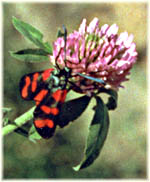

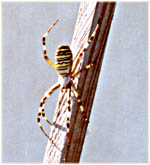
Schon bevor das Dach grünt und blüht, zeigen sich interessante Wesen in der Nähe. Bei dem Falter wird es sich um ein Blutströpfchen (Widderchen) handeln. Die Libelle wird eine Heidelibelle sein. Falls mir jemand einen Tip geben kann, ob das stimmt, würde ich mich sehr freuen. Die Spinne rechts ist eine Wespenspinne.
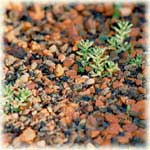
Anfang November zeigen sich die ausgebrachten Sedumsprossen wohl gestärkt. Dabei wurde nur nach dem Einstreuen einmal angegossen. Danach blieben sie ihrem Schicksal überlassen.
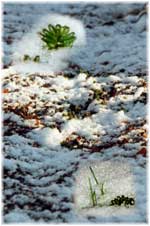
Ein milder Winter ließ die Sedumsprossen gut überleben, und selbst, als Ende Februar noch einmal kurz der Winter Einzug hielt, konnte der Schnee den kleinen Pflänzchen nichts anhaben. Jetzt freue ich mich schon auf die erste Blüte.
| Zusammensetzung der Samenmischung für eine extensive Dachbegrünung | |
| Lateinischer Name | Deutscher Name |
|---|---|
| Allium montanum Allium schoenoprasum Antennaria dioica Anthyllis vulneriaria Dianthus carthusianorum Dianthus deltoides Euphorbia cyparissias Hieraciom pilosella Hyppocrepis comosa Lotus corniculatus Petrorhagia saxifraga Potentilla neumanniana Prunella grandiflora Sedum acre Sedum album Silene nutans Thymus pulegioides Veronica teucrium |
Berglauch Schnittlauch Katzenpfötchen Wundklee Karthäusernelke Heidenelke Zypressenwolfsmilch Habichtskraut Hufeisenklee Hornschotenklee Felsennelke Frühlingsfingerkraut Großblütige Braunelle Scharfer Mauerpfeffer Weißer Mauerpfeffer Nickendes Leimkraut Feldthymian Großer Ehrenpreis |
Fledermäuse
Weiter unten zu finden:
Die Fledermaus-Kunsthöhle

- Material:
- unbehandeltes, sägerauhes Holz (Anwendung eines Holzschutz-Heißluftverfahrens empfehlenswert)
- Dargestellung
- Vorderansicht, Seitenansicht und der Blick von unten in den Kasten
- Arten
- Neben Flachkästen (u.a. für Zwerg- und Rauhhautfledermäuse) sollten geräumige Kastentypen (u.a. für Braune Langohre, Bechsteinfledermäuse) angebracht werden. Es empfiehlt sich des weiteren, kombinierte Vogel- / Fledermauskästen (z.B. Neschwitzkasten) zu verwenden.
Es wird benötigt (alle Angaben in mm):
- Bretter 15 dick: 450 x 250, 300 x 250, 130 x 310, 40 x 300 (2 Stück)
- 1 Leiste 20 x 40 x 700
- 1 abgeschrägte Leiste 20 x 30 x 220
- Holzkaltleim, Schrauben, Wandbefestigungsmaterial
Diese Darstellung der Fledermaus-Kunsthöhle Typ FS1 entstammt einer Informationsschrift des NABU (Naturschutzbund Deutschland) e.V.
Zitat aus dieser Publikation: Noch heute sind viele Einzelheiten aus dem Leben der Fledermäuse unbekannt. Nur mit Mühe gelingt es Fachleuten, sich ein einigermaßen zuverlässiges Bild vom Bestand dieser heimlichen Tiere zu verschaffen. Leider ist es oftmals so, daß Kolonien erst nach ihrer Zerstörung bekannt werden. Die Fledermauskundler sind daher an jeder Beobachtung von Fledermäusen interessiert, um der Beantwortung der vielen offenen Fragen ein Stück näher zu kommen. Bitte unternehmen Sie keine Alleingänge zu Ihnen bekannten Fledermausvorkommen, bei denen die Tiere unnötig gestört und oftmals auch geschädigt werden, sondern setzen Sie sich mit Fachleuten im Fledermausschutz in Verbindung, die über die nötigen Genehmigungen verfügen, die das Naturschutzgesetz zum Besuch von Fledermauskolonien vorschreibt. Kontakte zu Fledermaus-Fachleuten können Ihnen Naturkundemuseen, Naturschutzbehörden oder -verbände und die Bundesarbeitsgruppe Fledermausschutz im Naturschutzbund Deutschland vermitteln.
Meldungen von Bild der Wissenschaft
Fledermäuse "Schuld" an der Entwicklung der Schmetterlinge
(Meldung vom 21.1.2000)
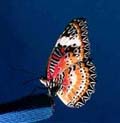 Auch die bei Tageslicht herum flatternden Schmetterlinge verdanken ihre Entwicklung vor allem den nachtaktiven Fledermäusen. Diese neue Erkenntnis haben Wissenschaftler der University of Toronto und der Carleton University nun in der Zeitschrift Nature veröffentlicht.
Auch die bei Tageslicht herum flatternden Schmetterlinge verdanken ihre Entwicklung vor allem den nachtaktiven Fledermäusen. Diese neue Erkenntnis haben Wissenschaftler der University of Toronto und der Carleton University nun in der Zeitschrift Nature veröffentlicht.
Die Forscher hatten das Ultraschall-Gehör von Nachtfaltern untersucht, bevor sie sich mit Anatomie und Verhalten der Tagfalter beschäftigten. Fledermäuse sind die wichtigsten Feinde aller nachtaktiven Insekten, so dass diese in ihrer Evolution Methoden entwickeln mussten, um Fledermäuse wahrzunehmen und geschickt zu vermeiden. "Die Mehrheit verwandelte sich von nachtaktiven zu tagaktiven Faltern, um so den Fledermäusen gänzlich zu entgehen. Für einige Arten der Nachtfalter bedeutete hingegen die Entwicklung eines ultraschallempfindlichen Gehörs, dass diese Insekten einen sensorischen Verteidigungsapparat hatten, um auch in der Nacht zu überleben", sagt James Fullard, Co-Autor der Studie.
Die Wissenschaftler hatten entdeckt, dass einige Nachtfalter mit außergewöhnlichen Flugmanövern (z.B. Sturz- oder Spiralflügen) begannen, sobald man sie einem Ultraschall-Stimulus aussetzte. Bisher war die Fähigkeit, Ultraschall wahrzunehmen, nur bei Motten und anderen nächtlichen Insekten bekannt, bei Faltern jedoch nicht. Die meisten Falter sind Tagfalter und sind dazu nicht fähig, weil ihre Tagaktivität sie ausreichend vor Fledermäusen schützt. Stattdessen haben diese einen ausgeklügelteren Sehsinn entwickelt, um anderen Feinden zu entgehen.
[Quelle: Iris Schaper und Eurekalert]
Wo soll denn nun die Höhle angebracht werden?
(Zitat aus dem Gästebucheintrag vom 17.2.2000)
... es sollte auch klar sein, wo und wie er aufgehängt werden muss. Also: Möglichst hoch an Bäumen, so dass die Fledermäuse direkt anfliegen können und nicht direkt gestört werden. Ausrichtung nach Süd-Osten, damit die Morgensonne wärmt. Keine Mittagsonne - die vertragen nicht einmal die wärmeliebenden Mausohren! Ein großes Problem der Fledermäuse in Mitteleuropa ist die Wohnungsnot: Sommerkästen sind also sehr wichtig.
von Gottfried Aust aus Tübingen
Bilder von Bettina Rosenlechner aus Südösterreich
Zitat aus ihrer E-Mail:
Eines schönen Tages im Sommer krabbelte auf dem Lichtschacht unseres Kellers plötzlich eine vermeintliche Vogelspinne, die sich dann als junge Zwergfledermaus entpuppen sollte.
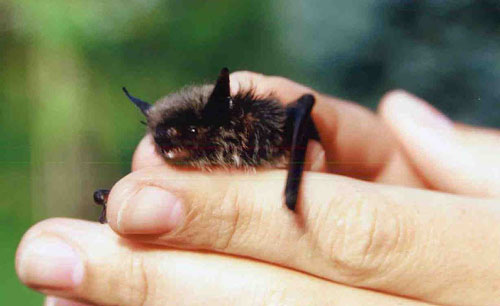
Als es zu dämmern begann, versuchten wir sie mit allen möglichen Tricks "loszuwerden": wir präsentierten sie den vorbeifliegenden Fledertieren :) auf dem Handteller, wir hängten sie auf der Wäscheleine auf, wir versuchten sie mit einem gespannten Leintuch zum Fliegen zu bewegen - alles vergebens. Wir zogen Erkundigungen ein, wie man das arme Ding bis zu seiner Abholung durchbringen könnte - und wurden dadurch zu - mittlerweile skrupellosen - Mehlwurmmördern. :) Dann kam der "Fledermaus - Beauftragte des Landes". Die Fledermaus hatte mich mittlerweile als Ersatz-Wärmeflasche anerkannt, der Beauftragte war mit der Pflege zufrieden und so bekamen wir ausnahmsweise mittels Sondergenehmigung die Erlaubnis, sie weiter zu umsorgen. Bald darauf kam dann eine Anfrage, ob wir nicht eine zweite hinzunehmen könnten - und so gesellte sich die zeternde Bartfledermaus hinzu.
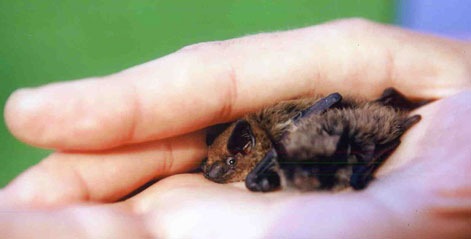
Nachdem wir ihnen in wochenlanger Arbeit beigebracht hatten, wie das mit dem Fressen und dem Fliegen nun mal so sei, mußten wir sie vor einigen Wochen dann schweren Herzens in die Freiheit entlassen.
Neue Kroatische Art
Per Mail erhielt ich 2003 dieses Bild einer neuen Kroatischen Fledermausart. Ihr lateinischer Name lautet: Pipistrellus pygmaeus. Ihr Gewicht beträgt gerade mal 2,4 Gramm.
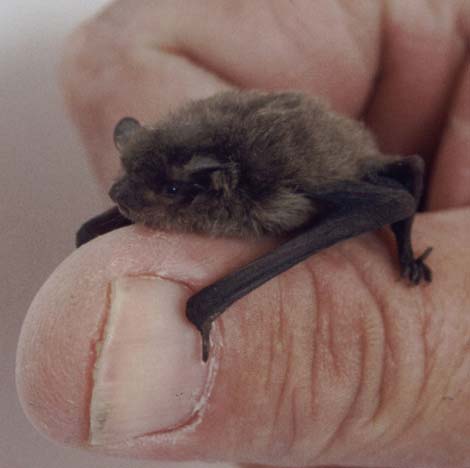
unsere Sonne (in Englisch)
Weiter unten zu finden:
About the Sun . . .
A Slideshow "The Sun: a Pictural Inroduction" you find at: www2.hao.ucar.edu
Author: P. Charbonneau and O.R. White (HAO/NCAR)
High Altitude Observatory/NCAR
- What is the Sun?
- Believe it or not, the Sun is just a star, just like those we see twinkling at night. The Sun, however, is so much closer to us on Earth that it looks much bigger, much brighter, and we can even feel heat coming from it.
Scientists know great deal about the stars that shine at night. Compared to these other stars, the Sun is actually quite average. Many of the stars that appear so small in the night sky are actually much bigger than our Sun. Others, however, are quite tiny in comparison. Some are much hotter, and some are so cool and dim we can barely see them. But for us on Earth, the Sun is just right! - What is the Sun made of?
- The Sun is made of hot gases, containing many of the same materials we find here on the Earth. These materials, called elements, include hydrogen, helium, calcium, sodium, magnesium, and iron. You can find all of these on any periodic table of elements.
Did you know that most of the atoms in our bodies were made inside stars? As the famous scientist and educator Carl Sagan says, we are "star stuff." - How big is the Sun?
- The Sun is HUGE! Even though it looks small in the sky it is actually bigger than you might imagine. It only looks small because it is 93 million miles away. (That's about 150 million km.) The Earth is very tiny compared to the Sun. In fact, if you think of the Sun as a basketball, the Earth would only be the size of the head of a pin -- a mere speck.
The Earth is about 13 thousand kilometers (8000 miles) wide, whereas the Sun is roughly 1.4 million kilometers (900,000 miles) across. This means it would take more than 100 Earths to span the width of the Sun! If the Sun were a hollow ball, you could fit about one million Earths inside of it! - How far away is the Sun?
- The Sun is very FAR from Earth. In fact, it is 93 million miles away. (That's about 150 million km.) If the Sun were the size of a basketball, and Earth the size of the head of a pin, the basketball and the pin would be separated by about 100 feet -- a third of a football field (30.5 meters). If you were standing at the basketball (and didn't have a telescope to help you), you wouldn't even be able to see the pinhead Earth.
Another way to understand the distance is to think of driving to the Sun in a car. If you actually could do this, and drove really fast, say 60 miles an hour (80 km/hr), it would take you 176 years to get there! Light from the Sun takes about 8 minutes to reach the Earth. If you understand how fast light travels, you can recognize that the Sun must be very far away. - How heavy is the Sun?
- Although we cannot actually weigh the Sun with a scale, we can compute its weight by studying the way it affects other objects, like the Earth. We do know that it contains virtually all the mass in our solar system! We can also understand this better by making some comparisons. Since the Sun is so much more massive than the Earth (over 300,000 times heavier) its gravitational pull is also much larger. A child that weighs 75 pounds on Earth would weigh about a ton on the Sun. The weight increases by a factor of 30. (Of course, we cannot really stand on the Sun, for it is too hot and has no solid surface.)
- How old is the Sun?
- The Sun is about 4 1/2 billion years old. Humans have only been around for a tiny, tiny fraction of this time. As a comparison, if you think of 4.5 billion years as the length of a 12 inch ruler, then the time humans have existed wouldn't even be the width of the lines marking the inches. (Metric equivalent is 30.5cm and it would still be just the width of the markings.)
The Sun will remain more or less the way it is now for about another 5 billion years. After that, it will exhaust the hydrogen it currently "burns" and will enter a new phase of existence. During this phase the Sun will begin "burning" helium and will expand to about 100 times its current size and become what is called a red giant. Once it runs out of helium it will collapse into a much smaller object called a white dwarf. - How hot is the Sun?
- The Sun is extremely HOT! The middle of the Sun is at least 10 million degrees. The "surface" of the Sun (what we see) is only 5800 degrees. This is cool for the Sun, but is actually about 16 times hotter than boiling water (ouch!). The outer atmosphere of the Sun (which we don't really see with our eyes) gets extremely hot again, about 1.5 to 2 million degrees. These huge temperature changes are very interesting to scientists.
- Why do we study the Sun?
- Without the Sun, life on Earth would not exist. Our planet would be a frozen dark ball, drifting dead in space. We need the Sun for light, heat and energy. With the Sun, plants can grow, and animals can eat. The Sun's output changes over time. These changes affect not only our daily lives and climate, but also our communications, such as by satellites. The more we know about the Sun, the better we can deal with these changes.
In the past, we know the Sun was a little different than it is now, and at those times the Earth experienced ice ages. During the most recent ice age, almost all of Canada and the Northern US was covered in a huge sheet of ice about a mile thick! (That's about 1.6 km.) Even recently (the late 1600s) Europe and North America were a bit cooler than they are now, experiencing a little ice age, and changes in the Sun were most likely responsible.
The ozone hole is something different. Ozone is important to humans because it shields us from harmful ultraviolet radiation from the Sun. The chemicals from leaky refrigerators and air conditioners make their way up in to highest part of the Earth's atmosphere. Way up there, these chemicals destroy ozone, and scientists have noticed recently that the layer of ozone in the upper atmosphere is becoming thin in some places. Scientists must study this so we can understand why it is occurring, and to take action now to protect it. It is interesting, however, that ozone is considered a pollutant when it is close to the ground. It hurts plants and trees, and our lungs. But we need it way up high to shield us from the UV.
Also, learning more about the Sun helps us to understand better other stars. And this helps us understand better the universe in which we live. - How do scientists study the Sun?
- Studying the Sun and how it affects the Earth is a very complicated process. In order to successfully do this, scientists approach the problem in many different ways. They separate their scientific efforts into categories and usually specialize in specific areas, such as How the amount of light from the Sun varies over time, or How the Sun's light affects the Earth's climate.
Some scientists study the Sun using computers to predict what the Sun may do in the future. Others build special instruments which look at the Sun and make measurements; they use computers both to collect and later make sense of the measurements. - What are the aurorae?
- The Aurora are colorful, whispy, moving curtains of light that occur in the night sky near one the Earth's poles. This light moves around in and changes color in a dazzling dance of light. The aurora are caused by energetic particles coming from the Sun. The Sun is very active, always putting stuff out into space. Every once in a while it can suddenly eject material -- a million tons of it -- into space. Some of this comes towards the Earth and hits our atmosphere.
The material (small particles) interacts with the Earth's outer atmosphere, causing the gas in the atmosphere to release light. This light appears in many different colors (green, blue, and red), and we call it the aurorae.
In the north they are called aurora boreallis, or northern lights. In the south they are called aurora australis, or southern lights. - What is an eclipse?
- Periodically the Moon will move directly in front of the the Sun. When it does, it blocks the light coming from the Sun. If it blocks out the Sun totally, we call this a total eclipse. If the Moon only blocks part of the Sun, it is a partial eclipse. You may wish to visit a real total eclipse, observed from the South American country Chile in 1994.
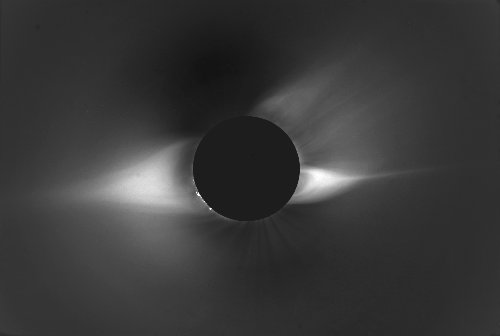
During a partial eclipse, you can still see part of the Sun behind the Moon, so you must not look at it. But, if you look at shadows from the leaves in trees you'll see they appear crescent shaped. Ask your teacher to make a pinhole camera, or project an image of the Sun using a mirror, and you'll be able to see the Moon blocking the Sun.
During a total eclipse, the bright Sun is completely blocked. At this time, the outer atmosphere of the Sun, or corona, becomes visible. During this brief occurrence, you can look at the corona with your eyes, because it is a million times dimmer than the Sun. Be very careful though -- even the slightest portion of the Sun poking past the edge of the Moon can hurt your eyes!
As you may know, the Moon is much smaller than the Earth, and it cannot block the Sun from the whole Earth at once. For this reason, eclipses only affect a small portion of the Earth's surface when they occur.
By the way, during a total eclipse, the stars are also visible! - Can the Sun be dangerous?
- Never look directly at the Sun, even with sunglasses. The human eye is not made to look at an object that bright. It is so bright it could easily blind you in just a few seconds. Have you ever looked at a bright light bulb and then had to look away after a short time? Well, the Sun is about a million times brighter than a household light bulb. This is why you can injure your eyes: if you look directly at the Sun, the inside of your eyes can burn severely and may never heal again. You could lose your sight permanently. In order to study the Sun, scientists look directly at the Sun only with the aid of special instruments that are made to tolerate the extreme brightness.
The Sun also emits harmful ultraviolet (UV) radiation, which can damage your skin and eyes. In fact, any tan is a sign of damage to your skin! A sunburn may hurt for a while, but damaging your skin over many years can cause many problems, including skin cancer. That is why you should always wear sunscreen of SPF 15 or higher when you will be out in the Sun for more than a few minutes. This applies even for cloudy days -- though not as bright as sunny days, much of the harmful UV light still comes through. Note that having a tan is little protection from skin damage, providing an SPF of only about 2. To help protect your eyes, use sunglasses that filter 100% of UV light. When you buy glasses, check for labels that say 100% UV Protection. People who don't protect their eyes when they are young run the risk of loss of sight when older, including getting cataracts. - How can you learn more?
- It is very easy to find out more about the Sun and how it affects the Earth. You can visit your local library, as well as discover the Web. But the best way: look at the ultimate slideshow.
Bilder der Sonnenfinsternis vom 11. August 1999
aufgenommen in Leipzig



Die maximale Bedeckung in Leipzig betrug etwa 92 %. Wolken waren immer mit im Spiel! Die Licht- und Wolkeneffekte trösteten über die unzureichenden Beobachtungsbedingungen hinweg.